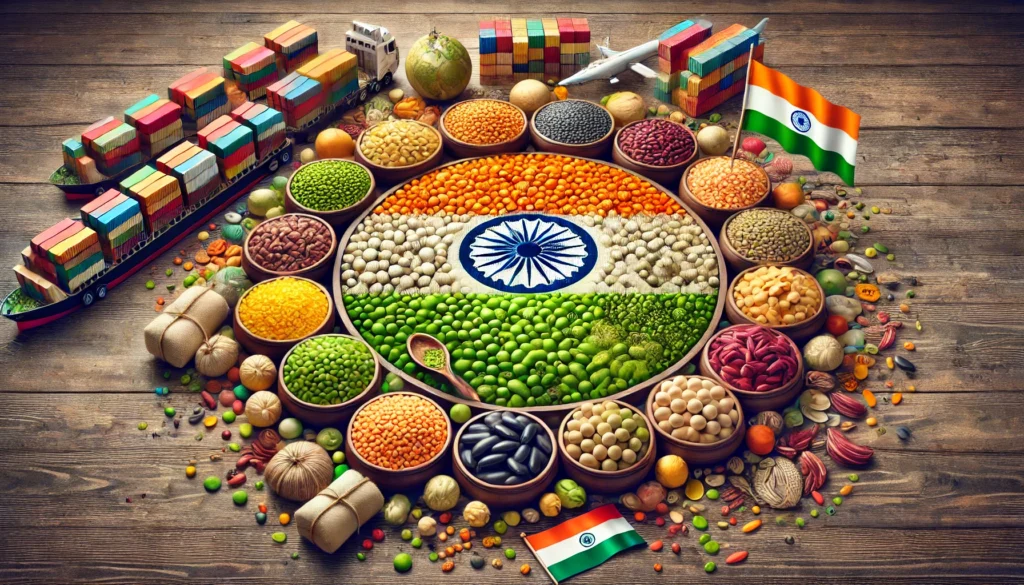
India, widely recognized for its rich agricultural heritage, is also a leading producer and exporter of pulses globally. Pulses, which are an essential source of protein, hold a prominent place in Indian agriculture and cuisine. The country’s varied agro-climatic zones facilitate the cultivation of numerous types of pulses, meeting both domestic and international demands. This blog delves into the types of pulses grown in India, the major exported varieties, and the key countries importing these pulses.
Types of Pulses Cultivated in India
India cultivates a wide array of pulses due to its diverse climate and soil conditions. Some of the major pulses grown in the country are:
- Chickpeas (Chana)
- Leading producers: Madhya Pradesh, Rajasthan, Maharashtra, Uttar Pradesh, and Andhra Pradesh.
- Variants: Desi and Kabuli.
- Lentils (Masoor)
- Key growing areas: Madhya Pradesh, Uttar Pradesh, and Bihar.
- Valued for their protein content.
- Pigeon Peas (Arhar/Tur)
- Predominant regions: Maharashtra, Karnataka, Uttar Pradesh, and Madhya Pradesh.
- A staple in Indian households.
- Green Gram (Moong)
- Main regions: Rajasthan, Maharashtra, Karnataka, and Andhra Pradesh.
- Known for its nutritional value and use in sprouted form.
- Black Gram (Urad)
- Grown in: Madhya Pradesh, Uttar Pradesh, and Tamil Nadu.
- Used in traditional dishes and as dal.
- Peas (Matar)
- Produced in: Uttar Pradesh, Madhya Pradesh, and Bihar.
- Utilized in fresh, dried, and split forms.
- Kidney Beans (Rajma)
- Cultivated in: Himachal Pradesh, Uttarakhand, and Jammu & Kashmir.
- A favorite in North Indian cuisine.
- Cowpeas (Lobia)
- Grown in: Gujarat, Karnataka, and Tamil Nadu.
- Known for its drought resistance.
Major Pulses Exported from India
India’s robust pulse production supports the export of several varieties. The prominent exported pulses include:
- Chickpeas (Desi and Kabuli)
- India ranks among the top global exporters.
- Lentils (Masoor Dal)
- Specific varieties like Red Lentils are in high demand in international markets.
- Pigeon Peas (Tur)
- Increasingly popular for its nutritional benefits.
- Green Gram (Moong)
- Highly valued for its health properties.
- Black Gram (Urad)
- Exported extensively to meet global demand.
Key Importing Countries
Indian pulses are exported to numerous countries across continents. Major importers include:
- Bangladesh
- A leading importer of lentils and chickpeas.
- United Arab Emirates (UAE)
- A significant market for chickpeas and lentils.
- Sri Lanka
- Imports pigeon peas and green gram in large quantities.
- Nepal
- Regularly procures lentils and other pulses from India.
- Malaysia
- Known for its demand for chickpeas and green gram.
- Saudi Arabia
- A growing destination for Indian pulses.
- United States and Canada
- High demand for Kabuli chickpeas and lentils.
- European Union
- Appreciates the quality and variety of Indian pulses.
Why Indian Pulses Are in Demand
- Diverse Varieties:
- India’s climate supports a wide range of pulses with high-quality standards.
- Nutritional Value:
- Rich in protein and essential nutrients, aligning with global health trends.
- Affordable Pricing:
- Competitive costs due to efficient production.
- Cultural Affinity:
- Countries with Indian communities often prefer Indian-grown pulses.
Challenges in Exporting Pulses
Despite its leadership in pulse production, India encounters several challenges in the export sector:
- Unpredictable Yields:
- Dependence on monsoon rains affects consistency.
- Regulatory Policies:
- Domestic supply concerns occasionally lead to export restrictions.
- Stringent Standards:
- Meeting the quality criteria of importing nations can be demanding.
- Global Competition:
- Rivals like Canada and Australia present tough competition.
Future Opportunities
As global awareness about the health benefits of pulses grows, India’s export potential looks promising. By enhancing agricultural practices, investing in better storage facilities, and optimizing export regulations, India can further solidify its position as a leading exporter of pulses.
Conclusion
The pulse industry is a cornerstone of India’s agriculture, contributing significantly to domestic consumption and exports. With strategic advancements, India can continue to play a pivotal role in meeting the global demand for high-quality pulses while ensuring economic growth and sustainability.


